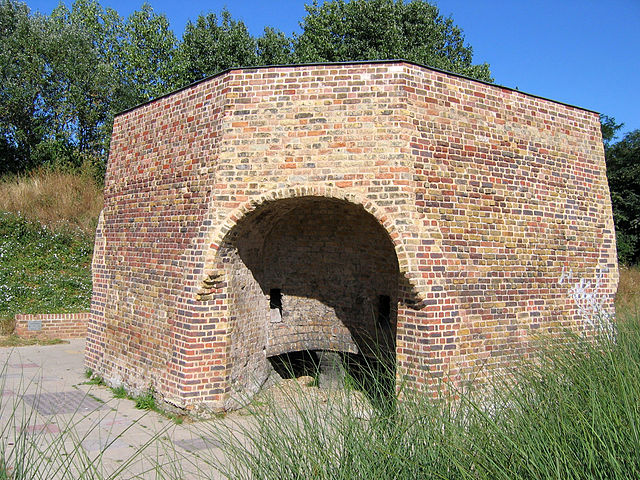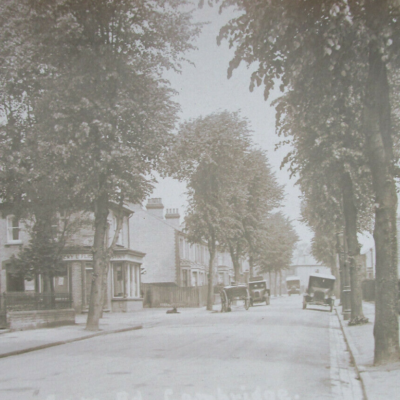Search by topic
- archaeology
- Building of Local Interest
- charity
- church
- crime
- dressmaker
- fire
- Great Eastern Railway
- Listed building
- Mapping Relief
- medieval
- oral history
- poverty
- Public House
- Rattee & Kett
- Religious House
- Roman
- scholar
- school
- Then and Now
- tudor
- women
- work
- world war one
- world war two
Search by text
 By Secretlondon - Own work, CC BY-SA 3.0, https://commons.wikimedia.org/w/index.php?curid=349800
By Secretlondon - Own work, CC BY-SA 3.0, https://commons.wikimedia.org/w/index.php?curid=349800Lime Kiln cottages
History of Lime Kiln cottages
The modern junction of Queen Edith’s Way and Cherry Hinton Road was a centre of lime manufacture until the end of the 19th century. The 1811 edition of ‘General view of the Agriculture of Cambridgeshire’ by Rev W Gooch states that lime was burned at Mepal, Wisbech and Cherryhinton and especially at Burwell. The author states that 100 bushels of burning lime cost 4s and ten bushels of coal are required to burn 40 bushels of lime.
The UK census returns point to a few families being involved in the industry in Cherry Hinton in the 19th century. For more information about the process visit these web sites:
http://www.outofoblivion.org.uk/lime.asp
http://www.lowtechmagazine.com/2013/09/lime-kilns.html
The available census information for those living around the lime kiln site is listed here:
Lime Kilns
1851 Elizabeth Layton head of family 38 pauper labs wife, Mary 16 empl. in fields, Susan 14 empl. in fields, Zillah 11 scholar, Adah 7, Elizabeth 5.
In 1841 Elizabeth Layton is listed (no address) as the wife aged 28 of William Layton Ag. Lab. with three children
1851 Susan Flack head of family 46 lime burner, Allen 22 lime burner, Susan 17, Mary 11 pauper scholar, Emma 6, Elizabeth 5.
In 1841 Susan is listed (no address) as the wife 40 of William Flack Ag.Lab. with 5 children
Lime Pits
1861 William Layton 60 labourer, Elizabeth 50 housewife, Susan 25 laundress, Zillah 21 laundress, Adah 19 laundress, Elizabeth 16 laundress, Elizabeth 4 granddaug, Elizabeth Thonly Layton 2 granddaug.
1861 Susan Flack widow 57 pauper
1861 Edward Hatly 29 lime burner, Susan 28 housewife, Emma 5 scholar, Edward 3.
Lime Kilns
1871 Henry J Tabor 34 lime burner, Mary wife 43, George 14 farm serv., Arthur 12 farm serv., Frederic 9 farm serv., William 7, Alice 5, Kate 4, Harry 3.
1871 Edward Hatly 38 lime burner, Susan 37, Edward 13 lime burner, Susan 11, John 6, Elizabeth 5, Albert 2.
Lime Kiln Road
1881 George H Tabor 24 lime burner, Naomi E 24, Ethel M 2, Charles H 4mos, Rhoda Pettit sis-in-law 10 scholar.
1881 Susan Flack 79, Susan Hatley dau. widow 46 laundress, Edward Hatley gr.son 23 ag.lab., John 16 ag.lab., Albert 12 ag.lab., Mary 8 scholar, Henry 2.
Trumpington Road ” Lime Pits”
1891 George Henry Tabor 35 lime burner, Naomi E 34, Lilly Ann 13, Ethel Maud 11, Chas Henry 10, Florence 7, Albert Geo 5, Lucy Alice 3.
1891 Daniel Hefford 46 general labourer, Eliza 44, George Fred 17, Emma Flora 12, William H 10, Daniel 8.
Albert George Tabor was a lance corporal in the 203rd Field Company Royal Engineers. he died of wounds on 14/11/1916 aged 31. Buried in Harbarq Communal Cemetery Extension, Pas de Calais.
Lime Pits
1901 George Tabor 45 lime burner, Naomi 44 laundress, Florence 18 laundress, Albert 16 clunch digger, Jessie 8
1901 Daniel Hefford 52 lime burner, Eliza 53
Lime Kiln Cottage
1911 William Hefford 30 acting fireman G E Railway, Eliza Hefford 65 widow
Lime Pit Cottages
1911 George Henry Tabor 56 lime burner, Naomi 56 laundress, Lucy Alice 24 laundress, Jessie May 18 laundress, Maud Bird 14 Grand Daughter, John Alfred Beeves boarder 30 bricklayer, Charles Monk boarder 28 tractor engine driver
Albert George Tabor, son of George and Naomi, died of wounds received 14 November 1916 in Flanders. He was a Lance Corporal in the 203rd Field Coy. Royal Engineers.
Sources: UK census
Contribute
Do you have any information about the people or places in this article? If so, then please let us know using the Contact page or by emailing capturingcambridge@
License
This work is licensed under CC BY-NC-SA 4.0








